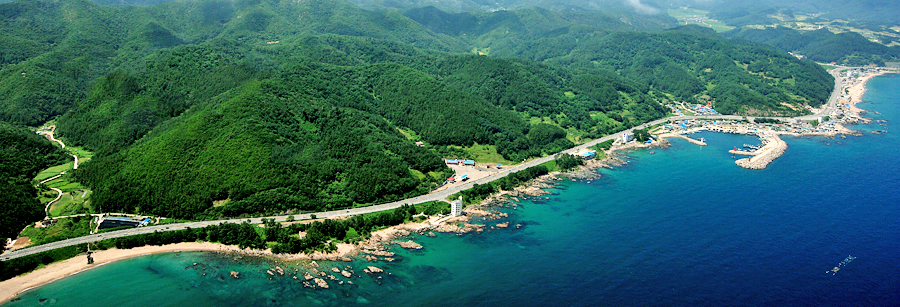

 > BlueRoad Story >
Story of Villages on BlueRoad
> BlueRoad Story >
Story of Villages on BlueRoad
Select each category and see the origin of villages in detail.
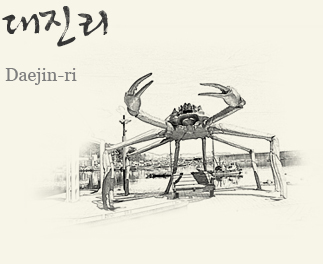
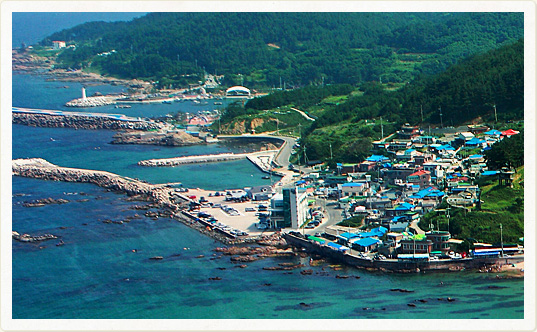
It was part of the town area in Yeonghaebu, and called 'Hannari', 'Hannalgi', or 'Daejin' as it is the sea front area.
The toponym of Daejin is found in "Gyeongsang-do Sokchan-Jiriji(Revised Gyeongsang Province Monograph)" published in 1469 and also can be found in the Population Census published in 1789.
Under the administrative district rearrangement in 1914, some part of Geondal-dong and Gongsujin were merged and renamed to Daejin-dong, and subsequently incorporated into Yeonghae-myeon.
In 1945, Gongsujin was divided into Daejin 1-dong, and Daejin was divided into Daejin 2-dong.
Meanwhile, Geondal was divided into Daejin 3-dong.
Later, Dong was renamed to Ri in 1988.
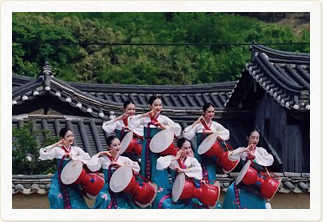
• The sound of the drum was tremendously loud, and the drum was placed in the middle of dancers who beat it while dancing. Mugo is one of the native dances during Goryeo Dynasty, which started in this way. The name of this dance originated from the following stories:
• Later, the Ihon Busa went up to Gaegyeong, and this dance spread to the royal court and became one of the native dances among the royal court dances.
• This gorgeous and beautiful dance is handed down to the current moment. Particularly, this dance is often performed at the National Gugak Center.
In a circle dance, 8 dancers beat one drum with the 4 dancers encircling the drum and beating it with drumsticks in both hands. The remaining 4 dancers perform the hyeommu, holding the flower drumsticks, called 'Samjihwa' in both hands or circling around or dancing at the corner. The drum used in this dance is slightly smaller than Gyobanggo, and has the structure with the drum frame being placed on the three columns. The blue, red, white, and black decorations are placed beautifully around the drum frame.
• Yeongdeok Mugo Art Group was organized in 2000 in Yeongdeok to pass the Mugo dance onto the county residents and inherit the tradition of the county as the origin of Mugo.
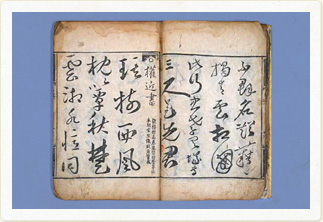
• Hwasangun Gwon Geun complied Dongguk-saryak, and was the vassal for the period spanning from late Goryeo to early Joseon. He was the scholar of Neo-Confucianism with excellent writing skill. He was born in Yeonghae and spent his childhood with his maternal parents. He was related with Mokeun Lee Saek by marriage. He went to exile in Yeonghae at late Goryeo in 1390 and wrote the Gaeksagimun of Yeongdeok precinct and Seorugimun of Yeonghaebu. Particularly, the Seorugimun of Yeonghaebu contains detailed description of the life and customs of residents in Yeonghaebu, along with the extensive details of Mugo which is the royal court dance originating from Yeonghae.
• From the 'Seorugi' of Gwon Geun
• Yeonghae was the Deokwon in the past. Blocked by mountain and adjoining the sea, the land is secluded, and therefore, the cool breeze is often blowing in summer and it is not very freezingly cold in winter. Fish, terrapin, abalone, clam, etc., are caught abundantly.
• When it was peaceful in the past, the people enjoyed prosperity. The lawsuit was simple, and all families had the geomungo(six-stringed Korean zither). People chose the strings coincidentally. They sang songs with clear voice and danced charmingly. The scenic beauty was analogous to that of fairyland.
• When Mongam Sijung Lee-hon went to exile in this village, he made the dancing drum from the tree floating on the sea and taught the moderation. The sound was loud and excellent, and the dance showed the successive alternation. It was more harmonious than a pair of butterflies quickening the arrival of spring.
• The agile and brave spirit is more dynamic than the two dragons attacking the enemy. That represents the most magnificent and bizarre scenery of Yeonghaebu, which cannot be found elsewhere.
• The inspectors and auditors came and explored the folk customs here, and made a tour of this village and found that it was a really beautiful and silky-smooth land.
• 曰 寧海 卽古德原也 阻山濱海地僻而隩 夏多凉風 冬無涸陰 魚鱉蝮蛤海錯攸産 在昔盛時 民豐訟簡 家畜絲桐 人工繰縵 歌喉舞態 旣淸以婉 至於亭臺之勝 殆若仙境 及蒙庵李侍中混 謫宦而來 乃得海上浮槎 製爲舞鼓 敎其節度 其聲宏壯 其舞變轉翩翩然 雙蝶繞花 矯矯然 二龍爭珠 和於催春 健於赴敵 最府之一奇而 他郡之所未有 觀風杖節之士 必來遊觀 實一方佳麗之地也
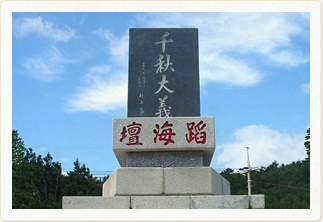
• The memorial stone, Dohaedan, is erected at the seaside of Daejin Port facing the rough waves and strong winds in the blue East Sea. This is the memorial stone for paying respect to General Byeoksan Kim Do-hyeon(1852~1914) who led the militias called the 'Righteous Army' and thew himself from the cliff to die for loyalty.
• Master Kim Do-hyeon was born as the eldest son of Kim Seong-ha, his father, and Ms. Hanyang Jo, his mother, at Cheonggi-myeon, Yeongyang-gun. He is the descendant of Kim Mun-gi who killed himself in his attempt to restore Danjong to the throne, and raised the army against the Japanese colonialists' suppression and forcible reform in political, social, and economic sectors, murder of Empress Myeongseong, ordinance prohibiting topknots which the Japanese troops -- stationed in Korea for the pretext of quelling the uprising of Gabo Peasants -- attempted to push forward with the assistance of pro-Japanese enlightenment-oriented regime.
• He fought against the Japanese troops in close range several times after raising the army for the first time at Mt. Cheongryang in 1896. He rushed to Sanggyeong with the confucian scholars of Yeongnam to appeal against the Eulsa Protectorate Treaty which was entered into forcibly in 1905. However, he failed to get his way, and returned to his home town after his comrades stopped him from committing suicide for the country. In 1907, he raised the army for the second time with Lee Mahn-do during the Jeongmi Militia Movement. In 1908, he established Yeongheung School to promote the militia movement and cultural enlightenment. But he decided to kill himself for the country as he could not suppress his outrage at the reality of Joseon that became the colony of the Japanese colonialists. After the death of his father in 1914, he left his will and life-ending poem at Daejin seaside, Yeonghae, and threw himself into the sea in November 1914 of the same year. A memorial stone facing the blue East Sea was erected to pay respect to him who is still protecting the homeland even after his death.
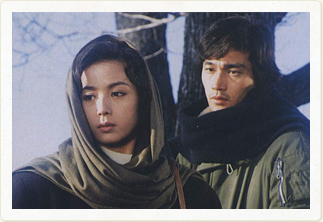
• Succumbing to the frustration and despair, Lee Mul-yeol, a novelist, arrives at the Daejin Beach after going over Changsuryeong Ridge covered with snow on bare foot to kill self.
• Lee Mun-yeol never forgets this day during his lifetime, and recalls the memory of his youth through the 'Portrait of Young Days', his masterpiece novel.
• From the 'Portrait of Young Days', a novel written by Lee Mun-yeol
• 《Changsuryeong Ridge, 700m above sea level》
• Ah! I saw the reality of beauty. I will never forget the three hours while I was going over Changsuryeong Ridge. No peaks in the world would give such amazing impression. If there is a perfect beauty that we can talk about, I saw it right there.
• Oh, all things that are great, sublime, and sacred because they are beautiful….
• I never forget the splendid beauty of the peak covered with snow and the mystery of the blue and shaded valley. I do not forget the pine tree with the branches torn apart by the snow piled up heavily and its sorrowful beauty. I never forget the tough and bold shape of the oak tree shined by the sunlight on the water from the snow melted away and the elegance of the larch standing like the bride wearing the wedding veil of snow.
• Even the challenging and arrogant Nogaju tree stands with humility. I see the sorrowful beauty of shy Mul-pure-julgi, kudzu vine and Siberian gooseberry vine in the valley covered with the black Tteok-gal-deung-geol, and azalea with its soft stalks barely penetrating through the snow piled up, and the white Sokse flower.
• I had the thrilling impression when the korean lespedeza which were scores of years old passed through the ridge. The black line of bush clover stalks against the backdrop of white snow forms the gorgeous, lofty and elegant beauty without being dreary.
• The sky became clear before I know it, and is shining all things with the dazzling light. The thin winter sky which looked rather clear and deep, and the high and steep peak of Taebaek at a far distance look more solemn than any grandeur peak well-known for the snow in the world.
• The flying mountain birds steer clear of that place, and even the wind seem to go around that place.
• I walked even without making the sound of breathing in the midst of the completely static conditions and the eternal universe sound. Due to the sore and swelling of the foot, I went over the hill mostly on bare foot, but I almost did not feel the pain.
• In that way, I was overwhelmed by the magnificent scenic beauty. When I went almost down the hill, I was almost shedding the tears of joy. No one would understand this joy. I looked at the reality of beauty. I realized that I did not perceive the thing that the aesthetician would call. The beauty was the beginning and end of all value, and was the collection of all concepts and absolute emptiness. The beauty is the truth, and the truth is the beauty. The beauty is the goodness, and the goodness is the beauty. The beauty is sanctity, and the sanctity is the beauty......
• However, the beauty per se does not have anything. At the same time, the beauty is open to all values, assigns and accepts all concepts. Moreover, the beauty has the greatness. The start this time was only for this moment.
Please refrain from inquiring about food and accommodation